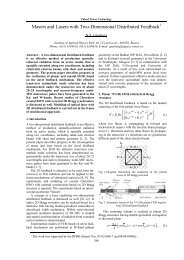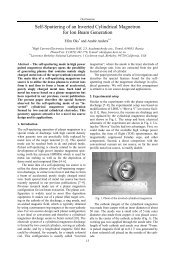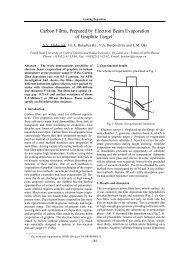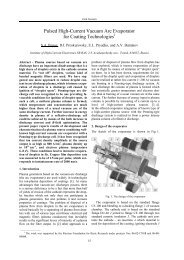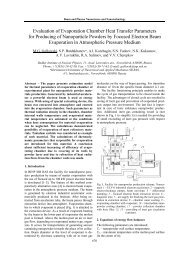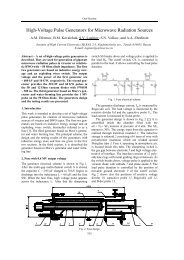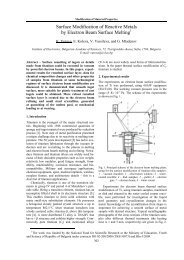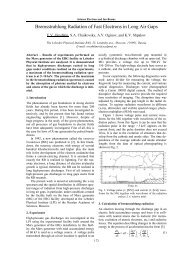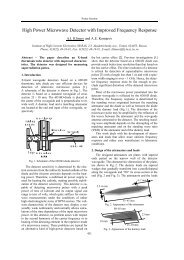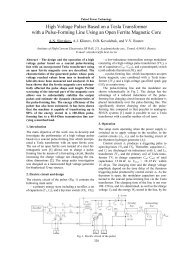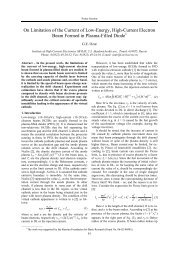Investigation of AuGeNi Ohmic Contact to n-i-GaAs Deposited by ...
Investigation of AuGeNi Ohmic Contact to n-i-GaAs Deposited by ...
Investigation of AuGeNi Ohmic Contact to n-i-GaAs Deposited by ...
Create successful ePaper yourself
Turn your PDF publications into a flip-book with our unique Google optimized e-Paper software.
Coating Deposition<br />
<strong>Investigation</strong> <strong>of</strong> <strong>AuGeNi</strong> <strong>Ohmic</strong> <strong>Contact</strong> <strong>to</strong> n-i-<strong>GaAs</strong> <strong>Deposited</strong><br />
<strong>by</strong> Different Methods<br />
E.V. Er<strong>of</strong>eev, V.A. Kagadei*, S.V. Ishutkin**, and K.S. Nosaeva***<br />
Research Institute <strong>of</strong> Semiconduc<strong>to</strong>r Devises, 99a, Krasnoarmeyskaia str., Tomsk, 634034, Russia<br />
Phone: +8(3822) 55-66-96, E-mail: er<strong>of</strong>eev@sibmail.com<br />
*Institute <strong>of</strong> High-Current Electronics SB RAS, 2/3, Academichesky ave., Tomsk, 634055, Russia<br />
**Tomsk State University <strong>of</strong> Control Systems and Radioelectronics, 50, Lenina ave., Tomsk, 634050, Russia<br />
***Research and production company ”Micran”, 43b, Vershinin str., Tomsk, 634045, Russia<br />
Abstract – The comparative analysis <strong>of</strong> parameters<br />
<strong>of</strong> ohmic contacts <strong>to</strong> n-i-<strong>GaAs</strong> deposited <strong>by</strong> the<br />
thermal evaporation <strong>of</strong> Au–Ge–Ni alloy or layer <strong>by</strong><br />
layer deposition <strong>of</strong> Ge, Au, and Ni films is carried<br />
out. That has been shown the values <strong>of</strong> the specific<br />
contact resistance <strong>of</strong> the layer <strong>by</strong> layer deposited<br />
ohmic contacts are more reproducible and the surface<br />
morphology <strong>of</strong> this contacts is smoother than<br />
in the case <strong>of</strong> contacts deposited <strong>by</strong> the Au–Ge–Ni<br />
alloy evaporation.<br />
1. Introduction<br />
<strong>Ohmic</strong> contacts parameters define characteristics <strong>of</strong><br />
MESFET and p-HEMT transis<strong>to</strong>rs as well as parameters<br />
<strong>of</strong> the MIMIC based on these transis<strong>to</strong>rs. At the<br />
technology node reduction the requirements <strong>to</strong> parameters<br />
<strong>of</strong> ohmic contacts, <strong>to</strong> their thermal stability<br />
and lifetime are increase [1]. In this connection the<br />
searching <strong>of</strong> the contact metallization optimal composition<br />
as well as effective deposition method is staying<br />
an actual problem.<br />
The work purpose is analysis <strong>of</strong> parameters <strong>of</strong> ohmic<br />
contacts <strong>to</strong> n-i-<strong>GaAs</strong> deposited <strong>by</strong> the thermal<br />
evaporation <strong>of</strong> the Au–Ge–Ni alloy or layer <strong>by</strong> layer<br />
deposition <strong>of</strong> Ge, Au, and Ni films.<br />
Surface morphology <strong>of</strong> the annealed contact pads<br />
was examined <strong>by</strong> methods <strong>of</strong> the scanning electronic<br />
and the a<strong>to</strong>mic force microscopy. The specific contact<br />
resistance ρ was measured <strong>by</strong> the TLM and Cox-<br />
Strack methods. The accuracy <strong>of</strong> the specific contact<br />
resistance measurement was 30%.<br />
3. Results and discussion<br />
In Figure 1, the SEM surface images <strong>of</strong> annealed<br />
ohmic contacts, deposited at the basic pressure<br />
2 ⋅ 10 –6 Torr <strong>by</strong> the thermal evaporation <strong>of</strong> Au–Ge–Ni<br />
alloy and layer <strong>by</strong> layer deposition <strong>of</strong> Ge, Au, and Ni<br />
films are presented.<br />
a<br />
c<br />
b<br />
d<br />
2. Experimental techniques<br />
Samples <strong>of</strong> the Si-doped n-i-<strong>GaAs</strong> (n ≅ 4 ⋅ 10 17 cm –3 ,<br />
d = 0.12 μm) and n + -<strong>GaAs</strong> (n ≅ 10 18 cm –3 ) were used<br />
in experiments. The two-layer resist mask with TLM<br />
patterns was produced <strong>by</strong> standard pho<strong>to</strong>lithographic<br />
techniques.<br />
For the <strong>GaAs</strong> native oxides removal samples were<br />
processed in H 2 SO 4 (1 : 10) water solution within<br />
3 min. After the treatment, samples were rinsed in<br />
deionized (DI) water and drying in N 2 flow.<br />
The <strong>AuGeNi</strong> film (0.15 μm) was deposited <strong>by</strong> the<br />
thermal evaporation <strong>of</strong> the alloy AuGe (88% / 12% wt)<br />
+ Ni (10% wt) and <strong>by</strong> layer <strong>by</strong> layer deposition <strong>of</strong> Ge<br />
(40 nm), Au (80 nm) and Ni (20 nm) films at the pressure<br />
2 ⋅ 10 –6 Torr. The <strong>to</strong>tal thickness <strong>of</strong> films was<br />
≅ 150 nm. The <strong>to</strong>pology <strong>of</strong> the contact pads was<br />
formed <strong>by</strong> the lift-<strong>of</strong>f process. Samples were annealed<br />
in nitrogen environment in furnace at temperature<br />
T = 350–460 °С during time t = 5 min.<br />
498<br />
Fig. 1. SEM images <strong>of</strong> the <strong>AuGeNi</strong> (a, b) and Ge/Au/Ni (c,<br />
d) ohmic contacts surface annealed at the optimal temperature<br />
(a, c) and at 460 °C (b, d)<br />
Both types <strong>of</strong> the contact metallization were deposited<br />
on n-i-<strong>GaAs</strong> samples. From the analysis <strong>of</strong> the<br />
grey contrast distribution along <strong>of</strong> the contact pad follows,<br />
that contact Ge/Au/Ni has homogeneous distribution<br />
<strong>of</strong> specific contact resistance and smoother<br />
morphology <strong>of</strong> the surface, than contact deposited <strong>by</strong><br />
the thermal evaporation <strong>of</strong> <strong>AuGeNi</strong> alloy. It is correct<br />
for annealing at the optimal temperature (temperature<br />
which corresponds <strong>to</strong> minimal ρ value), and for higher<br />
temperature (T = 460 °С) <strong>to</strong>o.<br />
In Figure 2, the AFM surface morphologies <strong>of</strong> annealed<br />
ohmic contacts both types are shown. These<br />
images are adjusting with the Fig. 1 data and testify
Oral Session<br />
that contacts Ge/Au/Ni have smoother surface morphology<br />
at all annealing temperatures.<br />
Fig. 2. AFM images <strong>of</strong> the <strong>AuGeNi</strong> (a, c) and Ge/Au/Ni (b,<br />
d) surface <strong>of</strong> ohmic contacts annealed at the optimal temperature<br />
(a, b) and at 460 °C (c, d)<br />
In Figure 3 the measurement results <strong>of</strong> the specific<br />
contact resistance <strong>of</strong> the <strong>AuGeNi</strong> and Ge/Au/Ni ohmic<br />
contacts, deposited on n-<strong>GaAs</strong> and n + -<strong>GaAs</strong> and annealed<br />
are presented. The temperature dependences has<br />
a traditionally curves shape with the ρ value minimum.<br />
a<br />
b<br />
c<br />
d<br />
499<br />
With the increasing <strong>of</strong> the annealing temperature<br />
the decreasing <strong>of</strong> the specific contact resistance is observed.<br />
<strong>Contact</strong> resistance, Ohm ⋅ cm 2<br />
10 –2<br />
1<br />
3<br />
4<br />
2<br />
10 –3 380 400 420 440 460<br />
Annealing temperature, °C<br />
10 –2<br />
10 –3<br />
10 –4<br />
10 –5<br />
10 –6<br />
<strong>Contact</strong> resistance, Ohm ⋅ cm 2<br />
Fig. 3. Dependence <strong>of</strong> the specific contact resistance<br />
<strong>of</strong> <strong>AuGeNi</strong> (1, 3) and Ge/Au/Ni (2, 4) ohmic contacts <strong>to</strong><br />
n-i-<strong>GaAs</strong> (1, 2) and n + -<strong>GaAs</strong> (3, 4) versus annealing<br />
temperature<br />
This is the result <strong>of</strong> the interdiffusion between ohmic<br />
contact metallization and <strong>GaAs</strong> and the formation<br />
doping interface layer. The increasing <strong>of</strong> the temperature<br />
leads <strong>to</strong> ρ growth as result <strong>of</strong> the high-resistance<br />
intermetallic AuGa phase formation [2].<br />
The minimal value <strong>of</strong> the specific contact resistance<br />
for Ge/Au/Ni contacts <strong>to</strong> n-i-<strong>GaAs</strong>, deposited<br />
<strong>by</strong> layer-<strong>to</strong>-layer method is 5 ⋅ 10 –4 Ohm ⋅ cm 2 at<br />
T = 420 °С. The Au–Ge–Ni ohmic contact, deposited<br />
<strong>by</strong> alloy evaporation in a point <strong>of</strong> a minimum has<br />
higher resistance ρ = 8.5 ⋅ 10 –4 Оhm ⋅ cm 2 at T = 410 °С.<br />
In case <strong>of</strong> n + -<strong>GaAs</strong> samples, minimal values <strong>of</strong> the<br />
specific contact resistance are ρ = 2.8 ⋅ 10 –6 Ohm ⋅ cm 2<br />
for layer-<strong>by</strong>-layer deposited Ge/Au/Ni ohmic contact<br />
and ρ = 4.5 ⋅ 10 –6 Ohm ⋅ cm 2 for Au–Ge–Ni contact,<br />
deposited <strong>by</strong> alloy evaporation.<br />
The degreasing <strong>of</strong> the specific contact resistance<br />
<strong>by</strong> fac<strong>to</strong>r 100 at increase <strong>GaAs</strong> doping level <strong>by</strong> fac<strong>to</strong>r<br />
2 is a result <strong>of</strong> high influence <strong>of</strong> the doping concentration<br />
on ρ.<br />
A series <strong>of</strong> the experiments devoted <strong>to</strong> research <strong>of</strong><br />
reproducibility <strong>of</strong> contacts <strong>to</strong> n-i-<strong>GaAs</strong> parameters has<br />
shown, that layer <strong>by</strong> layer contacts achieves the minimal<br />
contact resistance ρ = (4.2 ± 1.4) ⋅ 10 –4 Ohm ⋅ cm 2<br />
at temperature T = (420 ± 5) °С, while for Au–Ge–Ni<br />
contact achieves ρ = (5 ± 2) ⋅ 10 –4 Ohm ⋅ cm 2 at T =<br />
= (430 ± 30) °С. It is testifies that the layer <strong>by</strong> layer<br />
technology allows producing contacts with lowered<br />
contact resistance and also <strong>to</strong> higher reproducibility <strong>of</strong><br />
their parameters.<br />
4. Conclusions<br />
That has been shown that layer <strong>by</strong> layer deposited<br />
Ge/Au/Ni ohmic contacts has the reduced, more reproducible<br />
the specific contact resistance and smoother<br />
surface morphology at all annealing temperatures, in<br />
compare with contacts deposited <strong>by</strong> Au–Ge–Ni alloy<br />
evaporation.
Coating Deposition<br />
Acknowledgements<br />
We are grateful <strong>to</strong> A. Shigurov for carrying out the<br />
measurements <strong>by</strong> AFM.<br />
References<br />
[1] V.N. Kondariev and E.E. Nikitin, Chemical Processes<br />
in Gases, Moscow, Nauka, 1981, 264 pp.<br />
[2] V.S. Arutyunov and O.V. Krylov, Oxidative conversion<br />
<strong>of</strong> methane, Moscow, Nauka, 1998,<br />
361 pp.<br />
[3] Y.A. Kolbanovsky, I.V. Bilera, Generation <strong>of</strong> Synthesis-gas<br />
in the Electric Power Installations, Gas<br />
chemistry in twenty first Century. Problems and<br />
Perspectives, Ed. <strong>by</strong> A.I. Vladimirov, A.L. Lapidus,<br />
Moscow, Oil and Gas, 2003, 288 pp.<br />
[4] V.D. Rusanov, A.I. Babaritskiy, A.I. Gerasimov et<br />
al., in Proc. <strong>of</strong> Academy <strong>of</strong> Science 389, No. 3,<br />
324–327 (2003).<br />
[5] T. Kappes, T. Hammer, and A. Ulrich, in Proc. <strong>of</strong><br />
16 th International Symposium on Plasma Chemistry,<br />
Italy, 2003.<br />
500



